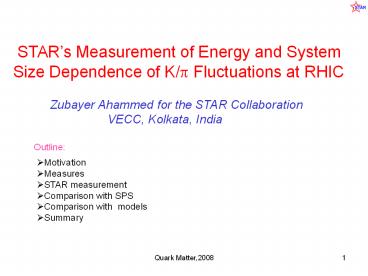STAR - PowerPoint PPT Presentation
Title:
STAR
Description:
Zubayer Ahammed for the STAR Collaboration. VECC, Kolkata, India. Outline: Motivation ... QCD predicts QGP phase transition at sufficient high temperature ... – PowerPoint PPT presentation
Number of Views:13
Avg rating:3.0/5.0
Title: STAR
1
STARs Measurement of Energy and System Size
Dependence of K/p Fluctuations at RHIC
Zubayer Ahammed for the STAR Collaboration
VECC, Kolkata, India
Outline
- Motivation
- Measures
- STAR measurement
- Comparison with SPS
- Comparison with models
- Summary
2
Motivation
- QCD predicts QGP phase transition at sufficient
high temperature/ energy density. - The nature of this phase transition can be
reflected in the increased/reduced fluctuations
in the global observables. - Kapusta and Mekjian J.I. Kapusta and A. Mekjien,
Phys. Rev. D33(1986)1304 - suggested that fluctuations in the Kaon to Pion
ratio can reflect the nature of phase transition.
3
K/p at SPS
- Strangeness production is related to
de-confinement. - Excitation function of ltKgt/ltpgt shows horn
around vsNN 7 GeV. - The excitation function of ltK-gt/ltp-gt is
monotonic.
C. Blume (NA49), hep-ph/0505137
4
K/p Fluctuations measurement
Event-by-event fluctuations in K/p may give
insight into the production mechanism of
kaons. NA49 measured the fluctuations of K/p as
a function of incident energy for central PbPb
collisions from vsNN 6 to 17 GeV using the
observable sdyn. Measure the K/p ratio
event-by-event. K K K- p p p- Produce
histogram of the K/p ratio. Extract the width of
K/p histogram to get sreal Do the same for mixed
event to get smixed
5
K/p Fluctuations at SPS
- Define the dynamical fluctuations in terms of sdyn
- Divide by the mean and multiply by 100
- to get
C. Blume (NA49), hep-ph/0505137
6
K/p Fluctuations in STAR
- Study AuAu collisions at vsNN 62,130 and 200
GeV. - Study CuCu collisions at vsNN62 and 200 GeV.
- Extract the number of K K- and p p-
event-by-event using energy loss and curvature in
the STAR TPC - Select kaons and pions with 0.2 lt pt lt 0.6 GeV/c
and - ? lt 1.0
- kaons Ns,K lt 2, Ns,p gt 2
- pions Ns,p lt 2, Ns,K gt 2
- electrons Ns,e lt 1
7
STARs K/p Histograms
STAR Preliminary
STAR Preliminary
CuCu 62GeV
CuCu 200 GeV
Data
Data
Mixed
Mixed
0-10
0-10
K/p for data and mixed events.
8
Measured sdyn
- Similar at 62 and 200 GeV for CuCu.
- Similar at 62,130 and 200 GeV for AuAu.
- Similar for CuCu and AuAu systems.
- Consistent with NA49.
9
Comparison with Statistical Hadronization Model
- Consistent with Torrieri with gq (1.6)
- fitted at higher energy.
- Inconsistent with Torrieri with gq1
- (equilibrium scenario)
AuAu(0-5) CuCu(0-10) NA49(0-6)
Girgio TorreiriNucl-th/0702062(2007)
10
Another Measure, ndyn
- The use of sdyn is problematic at smaller
multiplicities because it involves the
event-by-event fluctuation of a ratio. - A better measure is ndyn,Kp.
ndyn introduced to study net charge fluctuations.
(PRC 68, 044905 2003) ndyn,Kp is insensitive
to efficiency. ndyn,Kp properly deals with small
multiplicities.
11
Measured ndyn
STAR Preliminary
- Independent of energy for CuCu
CuCu
- 1/N centrality dependence
error stat.sys
a b/ (dN/dh)
STAR Preliminary
AuAu
- Independent of energy for AuAu .
- 1/N centrality dependence.
a b/ (dN/dh)
error stat. only
sys. error for AuAu17.6
12
System size dependence
STAR Preliminary
CuCu stat.sys.
AuAu stat.
sys. error for AuAu17.6
Independent of system size.
13
Scaled with dN/dh
AuAu stat.
CuCu stat.sys.
14
Comparison with SPS results
s2dyn ndyn
NA49 errors only stat. error shown
here Consistent with NA49 within errors.
CuCu stat.sys.
AuAu stat.
sys. error for AuAu17.6
15
For Charges Separately
STAR Preliminary CuCu 62 GeV
(C)
(A)
Error stat.sys.
STAR Preliminary CuCu 200 GeV
(B)
- Consistent with zero for same sign
- in data and Hijing .
- Higher in summed charge than same
- and opposite sign in data and Hijing
Error stat.sys.
16
Comparison with models
- AMPT, A Multi Phase
- Transport Model
STAR Preliminary
- Hijing hadronic evolution(
- multiple re-scattering)
In agreement with AMPT predictions.
CuCu stat.sys.
AuAu stat.
sys. error for AuAu17.6
17
Comparison with Scaled ndyn,Kp
CuCu stat.sys.
18
Summary
- We have measured K/p fluctuations on an
event-by-event basis using the measured sdyn and
ndyn,Kp. - The measured fluctuations is found to be
independent of energy. - Measured fluctuation is similar for CuCu and
AuAu system. - Measured fluctuation strength is consistent with
SPS results. - SH model (Torreiri) with fitted gq is consistent
at higher energy however the Equilibrium scenario
(gq1) under-predicts at all energies. - Hijing model over-predicts the measured K/p
fluctuations. - AMPT results (Hijing re-scattering) is in
better agreement with data.































